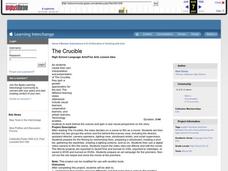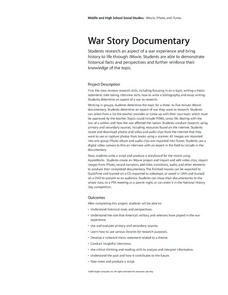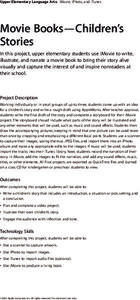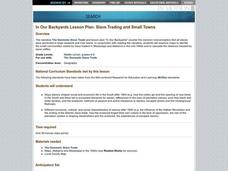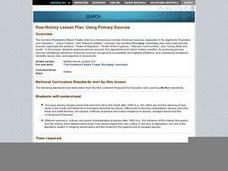Curated OER
An International Dinner Table
Learners investigate the origins of several crops eaten in the United States today. The facto0rs that influence consumer choices and the influences on the American population as to eating preferences are discussed in this lesson.
Curated OER
The Crucible
Pupils create a movie of a scene from The Crucible upon completion of reading the book. They assume a variety of roles in the film production.
Curated OER
War Story Documentary
Students review research skills and determine an aspect of war to research. They research an aspect of a war experience and bring history to life through iMovie.
Curated OER
Movie Books- Children's Stories
Pupils create movie books that make their stories come alive. They share these movie books with non-readers in an attempt to inspire them.
Curated OER
Past and Present
Students research their community history and choose on aspect to create an iMovie on. They use digital photographs and old images of community place that show how they have changed.
Curated OER
Feelings From A to Z
Third graders express and interpret information and ideas. They identify a variety of feelings and their effect on people. They explain how someone's actions can cause someone else to have a specific feeling.
Curated OER
The Blend Game
Students become stars of their own educational video in this project that allows learning in several different styles.
Curated OER
Feelings From A to Z
Third graders create a class A to Z Feelings book to explore emotions, discover new words, pose for a "feeling" icture, and write about the feeling.
Curated OER
Missouri Rice Farming
Sixth graders investigate rice farming in Missouri. In this percentages lesson plan, 6th graders determine how much rice production has increased over time. Students find this number in percentages. Students then figure the percent of...
Curated OER
Animated Project for Curriculum Areas
Learners use an animation program plan and create a short animation movie showing what they have learned in math or any other curriculum area.
Curated OER
Slave Auctions in South Carolina
Students examine primary sources in the form of auction records, create frequency charts, graphs and diagrams that they analyze to anwer questions followed by the writing of a paper that demonstrates their comprehension of the lesson.
Curated OER
The Phoenicians
In this Phoenicians worksheet, learners read a 4-page selection about Phoenician culture and then respond to 2 short answer questions based on the selection.
Curated OER
One Country's Slave Trade
Students examine the slave trade. In this research skills lesson, students research the slave trade in a selected country. Students use databases to locate pertinent information in order to prepare an oral presentation.
Curated OER
More Than One Grain of Rice
Students explore mathematics, geography and agriculture by studying world rice production. In this production of rice lesson, students read One Grain of Rice and use a worksheet grid to calculate how much rice was received. Students...
Curated OER
What is the history of rice in the United States?
Fifth graders become familiar with the history of rice and create a board game. In this rice lesson, 5th graders understand the history of rice through the playing of a game. Students use vocabulary words related to the history of rice.
Curated OER
Trade is Simple
Students gain a better knowledge that trade is part of everyone's daily life. They summarize that trade happens between people, even when they represent companies or countries. Students analyze how trade makes it possible to buy and...
Curated OER
Oil Market Basics
In this natural resources worksheet, students take a ten question quiz based on their knowledge of the oil market. This a multiple choice quiz.
Curated OER
Every Grain Counts
Students research a variety of facts about rice. They read books, access information on the Internet and use maps to determine major rice growing areas in the world and the patterns of distribution for this crop. Students create maps to...
Curated OER
How Many Types of Rice Are There?
Sixth graders investigate the cultivation and variation of rice around the world. In this food instructional activity, 6th graders read about the process of bringing rice from a farm to your dinner plate and which types of rice grow in...
Curated OER
What do they want? Critical Perspectives on the 1960's in the United States
Students determine that history is a field of study that can help them understand themselves and the people around them. By reading sources by and about people with many of the same interests and concerns that they have and learning to...
Curated OER
Major Compromises at the Constitutional Convention
In this Constitutional Convention compromises worksheet, students fill in the 20 blanks in 4 paragraphs regarding the details of 4 compromises made at the convention.
Curated OER
Fur, Feathers and Fins
Students examine the stages between growing the animal and buying it at the grocery store. In food system instructional activity students study the role that animal products have on nutrition and study animal agriculture.
Curated OER
SLAVE TRADING AND SMALL TOWNS
Pupils research the ways slavery shaped social and economic life in the South after 1800, the different economic, cultural, and social characteristics of slavery after 1800, and how the Atlantic slave trade finally ended.
Curated OER
RAW HISTORY: USING PRIMARY SOURCES
Students analyze the ways slavery shaped social and economic life in the South after 1800, how slaves forged their own culture in the face of oppression; and the role of the plantation system in shaping slaveholders and the enslaved.



